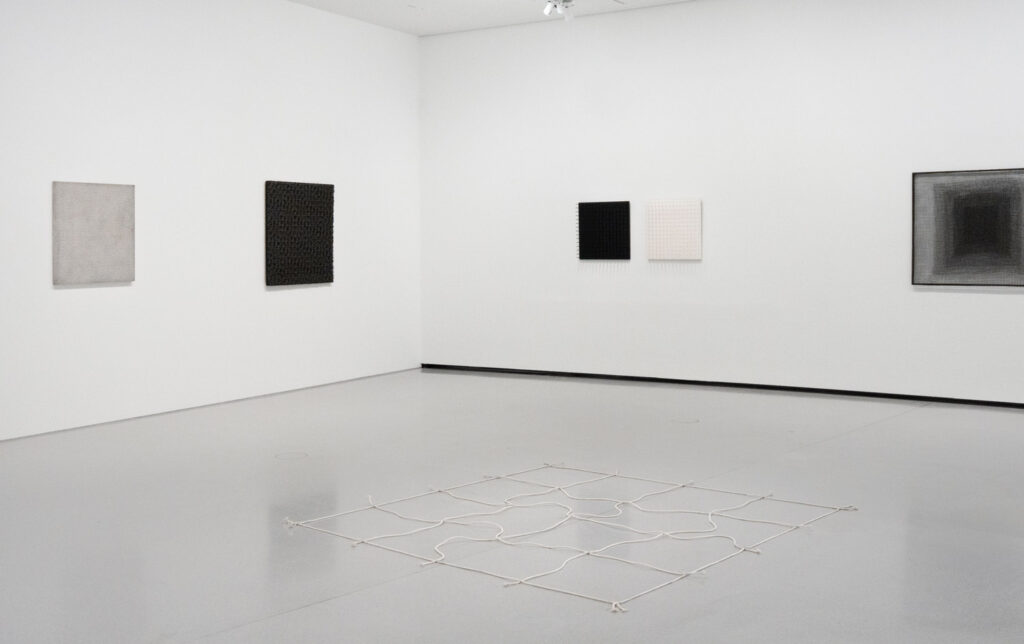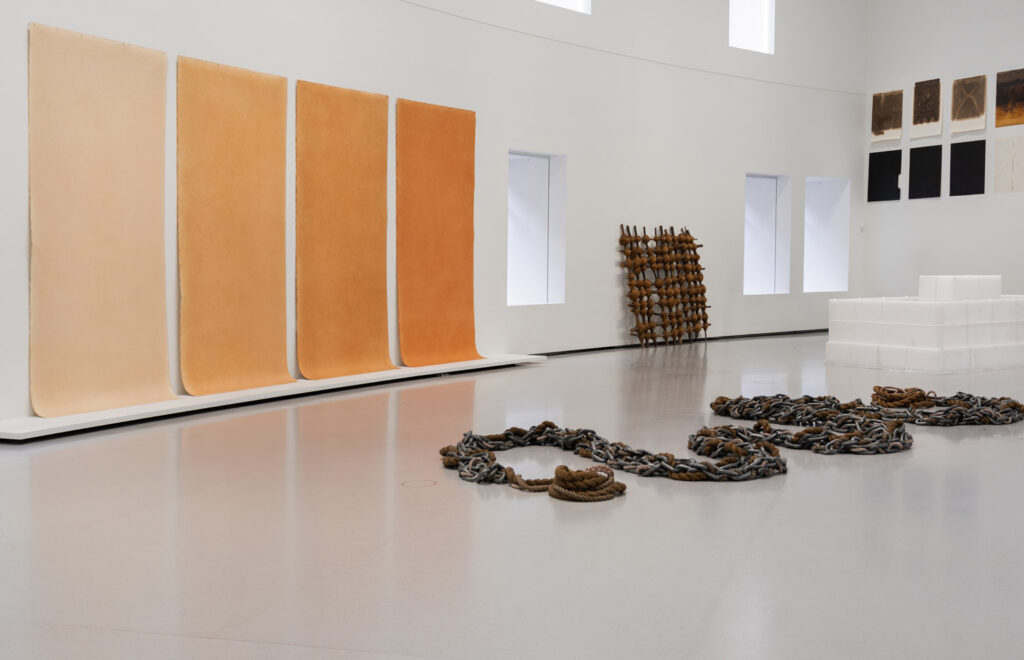At the beginning of November, I traveled to Paris with great anticipation to see the exhibition ‘Minimal’ at the Bourse de Commerce, never suspecting that I would leave it with a feeling of disappointment. Curated by Jessica Morgan, director of the Dia Art Foundation, the show promised to present Minimal Art not only as a US phenomenon but as a global, multifaceted discourse since the 1960s/1970s.
So the show seemed like a must-see for me – but, if I’m honest, I find it unusually difficult to write about the exhibition. And that’s surprising, considering how ideal the conditions seemed to be. Over a hundred works by 52 artists, including Donald Judd, Lee Ufan, Merrill Wagner, and others, shed light on minimalist art across seven themes, such as Light, Mono-ha, Balance, Surface, Grid, Monochrome and Materialism. These are complemented by sections dedicated to artists such as On Kawara, Agnes Martin, Lygia Pape, and Meg Webster. The unique exhibition venue provides the ideal setting. And yet, what I experienced fell short of my expectations.
But let’s start at the beginning: It was a beautiful, pleasantly warm, and sunny day for November – and my first visit to the city where it wasn’t raining! I was excited to see the show; it’s my first time at the Bourse de Commerce. Upon arrival, I was greeted by later works by Robert Ryman in the entrance area, the Salon. A nice start. In these special works, color, which had not appeared since his early experiments in the 1950s, makes a comeback. The textures and color nuances of the surfaces harmonize perfectly with the subtle hues at the edges of the paintings. I wanted to take my time to look and let the works affect me. But the Salon was bustling with activity; surrounded by people walking past the works to hand in their coats at the cloakroom, I found it unusually difficult to engage with Ryman’s works. People were walking around me, and I was careful not to accidentally step on the peppermint candies lying on the floor. These were, in fact, part of a work by Cuban-American installation artist Félix González-Torres entitled “Untitled (Portrait of Dad)” from 1991. I tried to find a connection between Ryman’s quiet, serene works and González-Torres’ emotionally charged, deeply personal work, but I couldn’t seem to grasp it.


Curious, I entered the large rotunda of the Bourse de Commerce and walked past cones, hills, and walls made of salt, earth, beeswax, twigs, and leaves – works by American artist Meg Webster. Webster, who has been working with natural materials since the late 1980s and whose practice lies between Land Art and Minimalism, always explores the relationship between humans, space, and nature in her installations. The five works appeared to be precisely placed, yet at the same time seemed somewhat lost in the large rotunda. I found myself more interested in the breathtaking architecture of the place than in the objects. The Bourse, the former Paris Stock Exchange from the 18th century, was only opened to the public in 2021 after Tadao Ando revitalized it with his contemporary architecture. I was fascinated by the interplay of historical architecture and modern Minimalism, and how the sunlight streamed through the glass dome.
I walked up the stairs, past Charlotte Posenenske’s industrial sculptures, and entered the first thematic section: Mono-ha. The Japanese art movement, which emerged in parallel with Western Minimal Art in the late 1960s and early 1970s, is also known as the “School of Things.” It emphasizes the raw presence of natural and industrial materials without altering them significantly. Artists such as Nobuo Sekine and Lee Ufan presented objects such as stones, wood, or metal in minimalist arrangements to explore the relationship between matter, space, and perception – a philosophical exploration of the essence of things. I enjoyed Lee Ufan’s work “From Line” from 1979 and walked around Susumu Koshimizu’s bronze floor sculptures from 1972. Koshimizu (b. 1944), a central representative of Mono-ha, devoted his work to the exploration of surfaces and volumes: he manipulated materials such as iron, wood, or – as here – bronze only minimally to reveal their inherent tension between form and space.


I really appreciate the curator’s approach of expanding Minimal Art geographically and thematically. In an interview with Beaux Arts, Jessica Morgan said, “It’s time to challenge the narrow thinking about this period and show that the reality is far more complex than it has historically been portrayed to be.” These words ran through my mind as I continued my tour through the galleries. I walked past works by Richard Serra, Donald Judd, and Merrill Wagner, but I also discovered many artists I hadn’t known before, such as Jackie Winsor and Michelle Stuart. Unfortunately, however, many of these unfamiliar works didn’t resonate with me at all. I looked at plastic bags filled with colored liquid, walked around large steel chains. I waited in vain for that familiar feeling Minimal Art usually evokes in me – and, for the first time, I can empathize with the confusion it provokes in so many others. I wondered if it’s the selection of works, the thematic categorizations, or the number of works per room, which was too large for my taste. But I don’t know.
Finally, I arrived at Gallery 4, a space dedicated solely to Agnes Martin. A quiet retreat. The ten works on display trace the transition from her early landscape-inspired compositions to her more structured, geometric works. In particular, the large-format works “Grey Stone II” and “The Dark River,” both from 1961, illustrate Martin’s fascinating understanding of rhythm and form. It was a moment when I had the opportunity to linger quietly and fully engage with my perceptions, a moment I wished there had been more of during this exhibition.


Once again, I walked through the galleries, trying to allow individual works to leave an impression on me. I wonder how the discourse and perception of minimalist art – beyond the boundaries of the Minimal Art movement – might change if it were no longer categorized by time, movements, gender, or geography. What if, instead, we focused on what artists across different contexts sought to explore through reduction, on the questions that unite them rather than the categories that divide them? Perhaps this might reveal a different understanding: one that arises more from perception itself rather than from classification. After all, the artists of Minimal Art were always concerned with placing the viewer at the center and enabling an immediate, physical, and sensual experience beyond narrative constructs or strictly formal interpretations. I feel that the exhibition remains trapped in the categorical without really replacing it with a fresh perspective.
Jessica Morgan’s attempt to present Minimalism as a global, multifaceted phenomenon while incorporating underrepresented positions is undoubtedly valuable and necessary. However, I leave the Bourse de Commerce with a sense of disappointment. Nevertheless, I invite everyone to visit this exhibition for themselves and form their own opinion, because perhaps that is precisely the value of this exhibition: to readjust one’s own view of Minimalism. I’m curious to hear your thoughts!
The exhibition “Minimal” runs through January 19 at the Bourse de Commerce in Paris.

